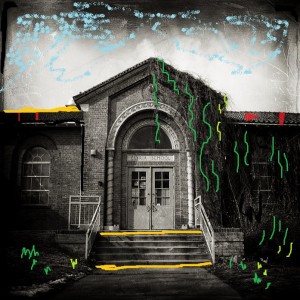1986-1991
A Flower Grows in Elyria
By Lisa Ramos
The success of Intro to Chicano History: 101 had a tremendous effect on Su Teatro. Heartened by new respect and recognition, members of Su Teatro organized around important goal which suddenly seemed more possible than ever: the purchase of a building to house a theater and cultural arts center for the Chicano community. The time was ripe, as the real estate market in the area was in a slump, thanks in part to Neil Bush and the S & L scandal. Along with a .01% sales tax that would go to supporting major arts institutions (oh yes and the rest of us got something) the climate was right for such a project.
Around 1998, Jerry Lawson suggested to Tony Garcia that Su Teatro consider purchasing the vacant school building in the Elyria neighborhood, a primarily Chicano/Mejicano barrio. Su Teatro had established criteria for a home: 1) that it be located in a Chicano neighborhood, not in an arts; 2) that the company purchase the building; 3) that it be located within five minutes of downtown. Although no one can remember the other criteria, and these seemed to fit, Tony was opposed to the idea. Elyria was a sleepy little community that smelled bad; Tony knew as he had been living there for the past eight years. He felt it was a bad match for Su Teatro; it was too far away from the action. Would people come out? Debra Gallegos was assigned to follow up on jerry Lawson’s suggestion. As fate would have it, Jerry García, a longtime friend and supporter of Su Teatro, was responsible for overseeing the building’s sale. In the old days Jerry had been the director of the Denver Inner City Parish and had given Su Teatro its first home at the “Parish.” The Centro consisted of an office and a stage; in grand fashion it was named El Centro Cultural de la Resistencia Chicana, it lasted about six months. Jerry García guided Su Teatro through the purchase of the Elyria Elementary School Building. El Centro Su Teatro opened on May 11, 1989 with an astronomical purchase price of $142,000, which would be considered a bargain today. The down payment came directly from community support. The Founding 250 supporters each donated $20 to raise the $5,000 needed. The previous 2 years of searching were only the beginning; the real work would now take place as the Elyria School started the transformation from chalkboards and lockers to dance studio, art gallery and blackbox theater. The company opened the new space with a string of incredible successes, a revival of Intor to Chicano History: 101 was followed by a three month run of Serafin: Cantos y Lagrimas. Serafin, loosely based on the diaries of playwright Tony García’s father, received critical acclaim, culminating in the receipt of the Denver Drama Critic’s Circle Award for Best New Play, and Best Play by Westword. The magazine also named Su Teatro’s purchase of the Elyria school building the Best Move of 1989. Elyria is a neighborhood surrounded by an oil refinery to the north, the National Western Stock Yards to the west, railroad tracks to the east and the Purina reprocessing plant and I-70 to the south, all of which claim that they are not responsible for the smell and pollution in the neighborhood. One day while filming a short documentary about El Centro, filmmaker Gary Swensen discovered a single rose growing in the south playground which until recently only grew weeds, some stretching upwards of three feet. The metaphor was not lost on him, that among the polluting weeds that had historically harmed Elyria, El Centro Su Teatro would be a flower growing in Elyria. (Lisa Ramos is an actor with Su Teatro; she is also a musician, singer, political activist, and an attorney.)


